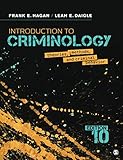Introduction to criminology : Theories, methods and criminal behaviour
Publication details: London Sage Publications 2011Description: 553p xixISBN:- 9781544339023
- 364.000000 HAG
| Item type | Current library | Call number | Status | Barcode | |
|---|---|---|---|---|---|
 BOOKs
BOOKs
|
National Law School | 364 HAG (Browse shelf(Opens below)) | Available | 29856 |
Browsing National Law School shelves Close shelf browser (Hides shelf browser)
Table of Contents
Preface
About the Authors
PART I: FOUNDATIONS OF CRIMINOLOGY
Chapter 1. Introduction to Criminology
Criminology
Crime and Deviance
Social Change and the Emergence of Law
The Crime Problem
Summary
Key Concepts
Review Questions
Web Sources
Web Exercises
Chapter 2. Research Methods in Criminology
The Research Enterprise of Criminology
Operationalization—Who Is Criminal?
Official Police Statistics—The Uniform Crime Report (UCR)
Alternative Data-Gathering Strategies
Experiments and Evidence-Based Research in Criminology
Surveys
Participant Observation
Case Study or Life History
Unobtrusive Measures
Validity, Reliability, and Triangulation
Summary
Key Concepts
Review Questions
Web Sources
Web Exercises
Chapter 3. General Characteristics of Crime and Criminals
Caution in Interpreting Crime Data
International Variations in Crime
Trends in Crime
Institutions and Crime
Summary
Key Concepts
Review Questions
Web Sources
Web Exercises
Chapter 4. What Is Victimology?
Nature of Victimization
Costs of Victimization
Theories of Victimization
Victims’ Rights
Summary
Key Concepts
Review Questions
Web Sources
Web Exercises
PART II: THEORIES OF CRIMINOLOGY
Chapter 5. Early and Classical Criminological Theories
Theory
Demonological Theory
Classical Theory
Neoclassical Theory
Ecological Theory
Economic Theory
The Theory–Policy Connection
Summary
Key Concepts
Review Questions
Web Sources
Web Exercises
Chapter 6. Biological and Psychological Theories
Positivist Theory
Biological Theories
More Recent Biological Theories
Psychological Theories
The Theory–Policy Connection
Summary
Key Concepts
Review Questions
Web Sources
Web Exercises
Chapter 7. Sociological Mainstream Theories
Anomie Theories
Social Process Theories
Social Control Theories
Developmental and Life Course (DLC) Theories
The Theory–Policy Connection
Summary
Key Concepts
Review Questions
Web Sources
Web Exercises
Chapter 8. Sociological Critical Theories and Integrated Theories
Mainstream Versus Critical Criminology
Labeling Theory
Conflict Criminology
Conflict Criminology and Race: W. E. B. Du Bois
Feminist Criminology
New Critical Criminology
Postmodernism
Radical Marxist Criminology
Integrated Theories of Crime
Criminal Typologies
Theoretical Range and Criminological Explanation
The Theory–Policy Connection
Summary
Key Concepts
Review Questions
Web Sources
Web Exercises
PART III: CRIME TYPOLOGIES
Chapter 9. Violent Crime
History of Violence in the United States
Murder
Homicide and Assault Statistics
Patterns and Trends in Violent Crime
Typology of Violent Offenders
Sexual Assault
Robbery
Domestic Violence
Criminal Careers of Violent Offenders
Societal Reaction
Theory and Crime
Summary
Key Concepts
Review Questions
Web Sources
Web Exercises
Chapter 10. Property Crime: Occasional, Conventional, and Professional
Occasional Property Crimes
Conventional Property Crimes
Arson: A Special-Category Offense
Criminal Careers of Occasional and Conventional Property Criminals
Professional Crime
Criminal Careers of Professional Crime
Societal Reaction
Theory and Crime
Summary
Key Concepts
Review Questions
Web Sources
Web Exercises
Chapter 11. White-Collar Crime: Occupational and Corporate
White-Collar Crime—The Classic Statement
Measurement and Cost of Occupational and Corporate Crime
History of Corporate, Organizational, and Occupational Crime
Cons and Scams
Big Cons
Legal Regulation
Occupational Crime
Corporate Crime
Criminal Careers of Occupational and Organizational Offenders
Societal Reaction
Theory and Crime
Summary
Key Concepts
Review Questions
Web Sources
Web Exercises
Chapter 12. Political Crime and Terrorism
Ideology
Political Crime: A Definition
Legal Aspects
Crimes by Government
Crimes Against Government
Terrorism
Crime Careers of Political Criminals
Societal Reaction
Theory and Crime
Summary
Key Concepts
Review Questions
Web Sources
Web Exercises
Chapter 13. Organized Crime
Sources of Information on Organized Crime
Types of Organized Crime
Organized Crime Continuum
Street Gangs
International Organized Crime
Nature of Organized Crime
Money Laundering
Drug Trafficking
Theories of the Nature of Syndicate Crime in the United States
Classic Pattern of Organized Crime
Crime Careers of Organized Criminals
Societal Reaction
Theory and Crime
Summary
Key Concepts
Review Questions
Web Sources
Web Exercises
Chapter 14. Public Order Crime
Broken Windows
Prostitution
Sexual Offenses
Drug Abuse
Societal Reaction
Theory and Crime
Summary
Key Concepts
Review Questions
Web Sources
Web Exercises
Chapter 15. Cybercrime and the Future of Crime
Types of Cybercrime
Types of Attacks on Computer Systems
Argot of Cybercrime
Online Predators
Cyberterrorism
Societal Reaction
The Future of Crime
Theory and Crime
Summary
Key Concepts
Review Questions
Web Sources
Web Exercises
Learning Check Answers
Glossary
References and Further Readings
Index
There are no comments on this title.







